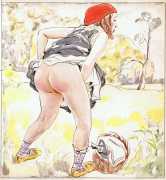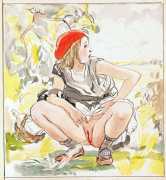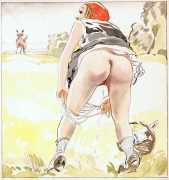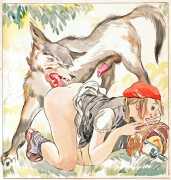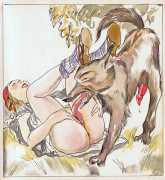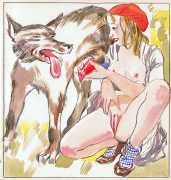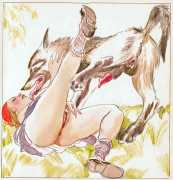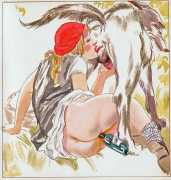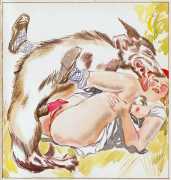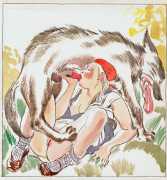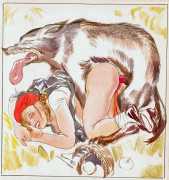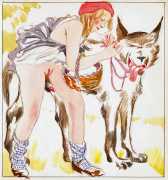The Rojan illustrations in this portfolio depict juvenile sexual exploration and bestiality, both of which are not only taboo subjects but are also – if they were being depicted in photographs rather than drawings – illegal in many countries (though interestingly not in Russia, Japan, Chile, Hungary, Finland and Romania!). If you need reassurance about the legality of Rojan’s drawings, even where there are laws against bestiality they usually relate only to (this is from the UK Criminal Justice Act 2008) ‘performing an act of intercourse or oral sex with an animal in an explicit and realistic way’. Rojan’s drawings may be imaginative, but are in no way realistic. No wolves or innocent young girls were hurt in the making of this portfolio. So, if you choose not to explore further, press the ‘back’ button now. You have been warned …
 Le petit chaperon rouge (Little Red Riding Hood) is one of the best-known European fairy tales, its origins traceable to the tenth century. The best known versions are that of Charles Perrault, written in the 1690s, and the Brothers Grimm’s 1812 Rotkäppchen.
Le petit chaperon rouge (Little Red Riding Hood) is one of the best-known European fairy tales, its origins traceable to the tenth century. The best known versions are that of Charles Perrault, written in the 1690s, and the Brothers Grimm’s 1812 Rotkäppchen.
Rojan’s portfolio is subtitled ‘Pour les grands enfants’ (for big children), making it clear that the tale has very grown-up overtones. He suggests that far from being a victim, Little Red Riding Hood is a young woman with a wild nature not unlike the wolf’s. Girl and wolf appear to be consensual partners in an exploration which they are both clearly enjoying – it can be read as a story of female empowerment and rite of passage.
Sexual analysis of Little Red Riding Hood has sometimes been given negative connotations in terms of rape or abduction. In Against Our Will (1975), Susan Brownmiller describes the tale as a description of rape; however, many revisionist retellings choose to focus on empowerment, and depict Little Red Riding Hood successfully defending herself against the wolf. Possibly most notably, Little Red Riding Hood appears in Angela Carter’s short story ‘The Company of Wolves’, published in The Bloody Chamber (1979), a collection of dark, feminist fables filled with bestial and ferocious heroines. In her version of the classic, Carter examines female lust, which is healthy, challenging, and sometimes disturbing.
 Rojan’s Le petit chaperon rouge appears to have been a private commission. As well as the series of twelve coloured pencil drawings, he also made several preliminary sketches and a larger watercolour painting on the same subject.
Rojan’s Le petit chaperon rouge appears to have been a private commission. As well as the series of twelve coloured pencil drawings, he also made several preliminary sketches and a larger watercolour painting on the same subject.
We are very grateful to Hans-Jürgen Döpp for these images; Hans-Jürgen, the compiler of many books on erotic art, curates the Venusberg online gallery and bookshop which you can find here.


